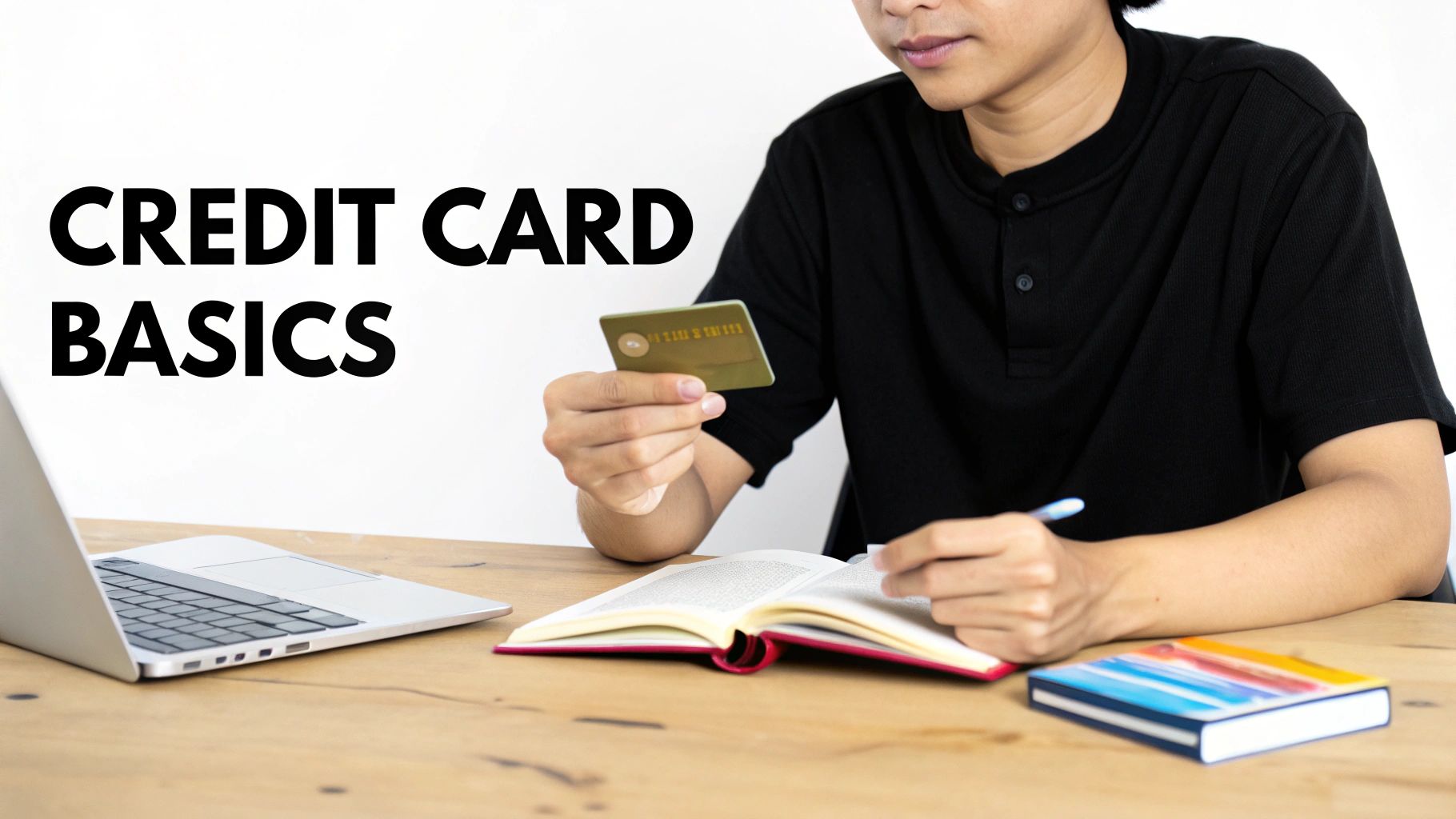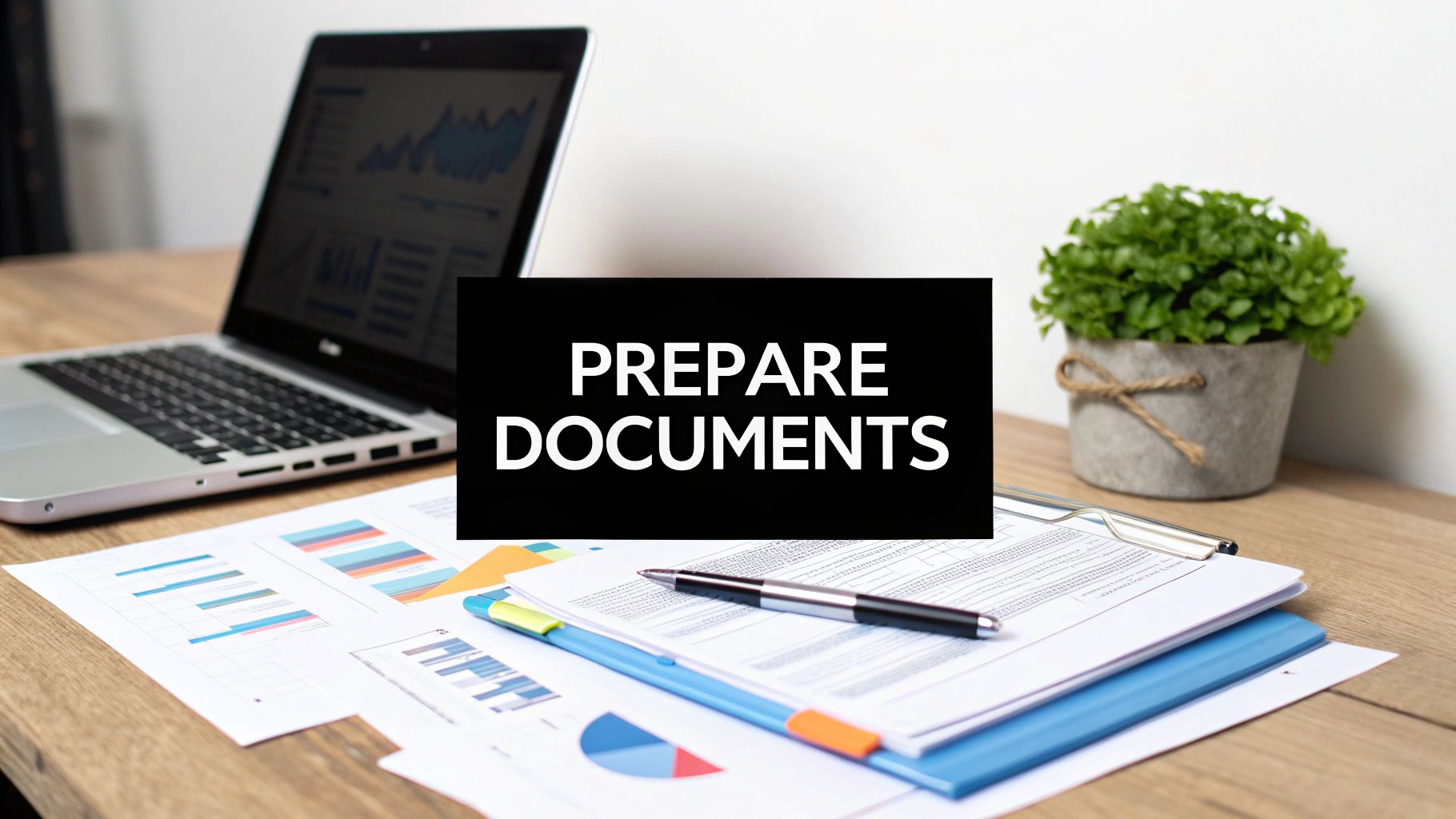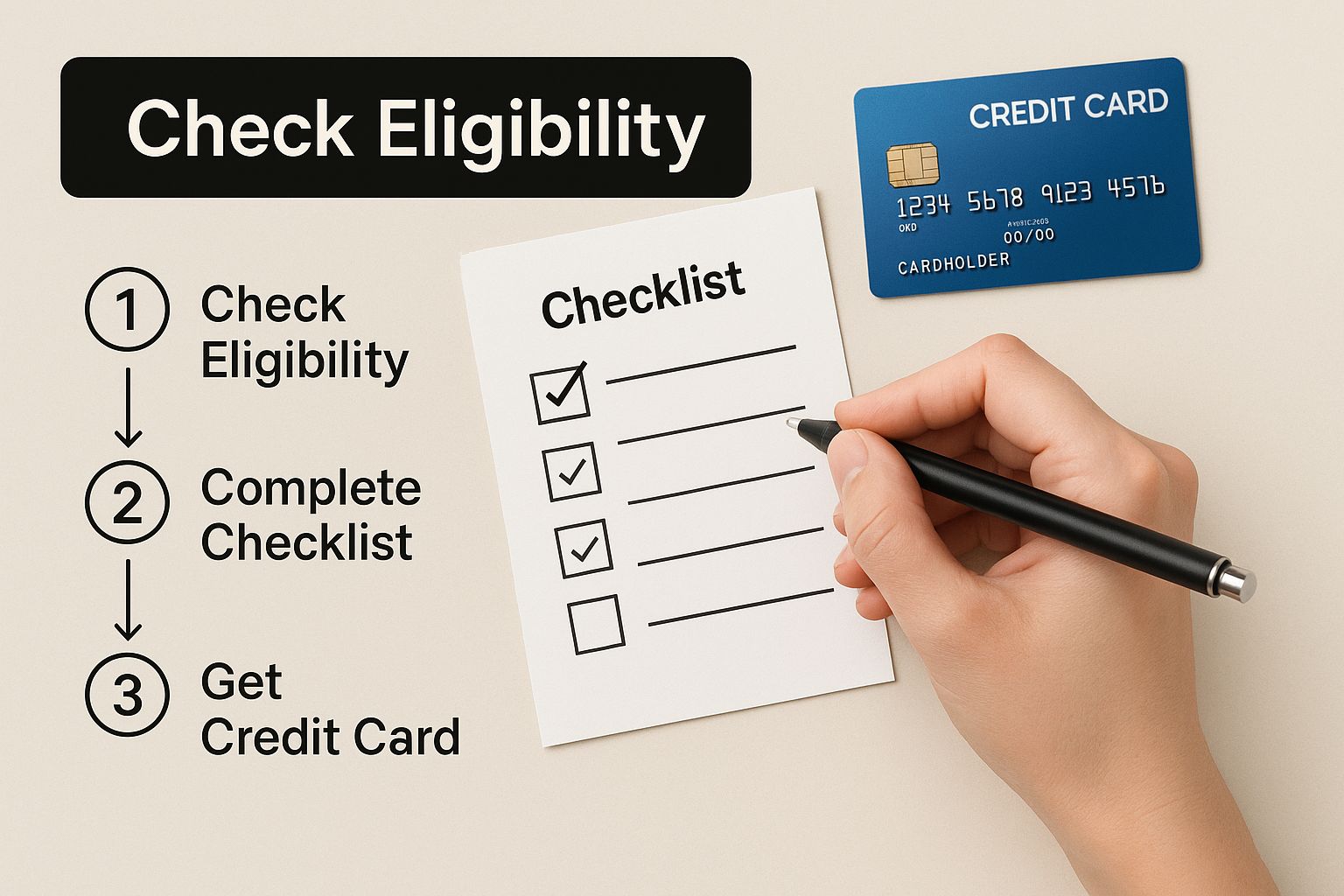Your First Time Credit Card Application Guide

Applying for your first credit card is all about solid preparation. It’s less about having a perfect financial past and more about showing you're a responsible person ready to handle credit. Think of it as assembling a puzzle—get all your pieces in order first, and the final picture comes together smoothly.
What You Need Before Applying for Your First Card

Jumping into the world of credit for the first time can feel a little intimidating. The biggest question I hear is, "How can I get a credit card if I don't have any credit history?" It seems like a catch-22, right? Lenders look at your past behavior to predict your future reliability, so a blank slate can be a hurdle.
But here's the good news: you're not alone. Far from it. The market for starter credit cards is massive—it was valued at $293.6 billion in 2022 and is only getting bigger. This isn't some niche corner of finance; it's a core part of the industry designed specifically for people like you. Financial institutions know there's a huge need for products that serve as a bridge into the credit world.
Gathering Your Application Essentials
Before you even think about which card you want, let's get your personal file ready. When you apply, banks are legally obligated to confirm who you are and that you have a way to pay your bills. Getting this stuff together now will save you a ton of headaches later.
Here’s what you’ll almost always be asked for:
What It Means to Start with No Credit History
If you've never had a loan or credit card before, you don't have a "bad" credit score—you just don't have one at all. It’s an empty file. This is totally normal for a first-time credit card application, so don't let it discourage you.
The entire point of a "starter" or "beginner" credit card is to give you a tool to fill that file with positive information. Every on-time payment you make helps build a strong credit history from the ground up.
To give you a clearer picture, here’s a quick breakdown of the common entry points into the credit world.
Beginner Credit Card Options at a Glance
This table compares the most common types of credit cards suitable for first-time applicants to help you understand your initial options.
Each of these options serves a different purpose, but they all share a common goal: to help you get started.
A secured card is often the most recommended route because it's low-risk for the bank. You provide a cash deposit, and that amount usually becomes your credit limit. Another great strategy is to become an authorized user on a trusted family member's card. Their good payment history can help you build yours.
If you want to dig deeper into these strategies, our guide on how to build credit from scratch is a great resource. The key is to pick the right starting line for your race.
How to Choose the Right Starter Credit Card

Okay, you’ve got your documents ready. Now comes the part that can feel like standing in a maze: picking the right credit card. You’ll see a flood of offers, each one dangling shiny rewards and tempting low rates. It's easy to get sidetracked.
But for your very first card, your mission is laser-focused. You need the one card that gives you the cleanest, most reliable path to building a solid credit history.
Forget the fancy travel points and cashback deals for now. Those can come later. Your primary goal is to establish a positive payment history that tells future lenders, "This person is responsible." That means looking for cards built for credit-building, not for maximizing perks.
Focus on the Fundamentals, Not the Frills
When you’re comparing cards, the flashy features aren't what matter most. Instead, zoom in on the core elements that will actually affect your financial health and whether your application gets a "yes."
Here's what you should really be looking at:
Secured Cards: The Smartest Starting Point
For most people applying for the first time, especially with an ITIN, a secured credit card is the most strategic move you can make. Yes, it requires a small, refundable security deposit upfront, but that deposit is precisely what makes it so accessible.
This deposit—usually between 200 and 500—sets your credit limit and dramatically lowers the bank's risk in lending to someone with no credit file.
Let’s look at a real-world example. Maria, an ITIN holder, had a good job but no U.S. credit history. She got denied for a standard unsecured card. Instead of getting discouraged, she applied for a secured card and put down a 300** deposit. She was approved instantly. For the next year, she used it for small purchases like groceries and paid the bill in full every single month. After a year of perfect payments, the bank refunded her **300 and automatically upgraded her to a traditional, unsecured card.
This approach is so much better than getting a retail store card, which might seem easier but often comes with high interest rates and is less versatile. Secured cards are designed to be a stepping stone.
Here’s your checklist for picking the right card:
Making the right choice here sets the entire tone for your credit journey. By focusing on these fundamentals, you’re not just getting a card—you’re choosing a partner that will help you build a better financial future.
Getting Your Application Ducks in a Row
Applying for your first credit card is more than just picking a card and hoping for the best. A successful application hinges on presenting your information clearly and correctly. Trust me, taking a few minutes to gather everything beforehand can save you from the headache of a denial caused by a simple mistake.
Here’s a quick look at the essentials you'll want to have on hand.

Think of these as the fundamental building blocks of your application. They prove who you are and that you’re eligible to apply, which is the very first hurdle you need to clear.
Your Personal Info Checklist
Let's get specific. Before you even start filling out a form, have these details ready and give them a quick once-over for accuracy. A single typo is all it takes to derail an otherwise perfect application.
What Really Counts as Income?
This is where I see a lot of first-time applicants get stuck. It's easy to think "income" just means a paycheck from a 9-to-5 job, but it's much broader than that. What lenders really want to know is if you have the means to pay back what you borrow.
If you're 21 or older, you can typically report any income you have reasonable access to. That can include:
The trick is to calculate your total annual income honestly. For instance, if you make 15,000** a year from your job and your parents regularly give you **300 a month (3,600** a year) for bills and groceries, your reportable income is **18,600.
Don't panic if your income feels low or isn't consistent. That’s precisely why secured cards and tools like a credit builder account exist. They are designed for people in your exact situation, giving you a way to build a positive credit history without needing a huge salary. By preparing properly, you're showing lenders you're a responsible applicant, and that goes a long way.
A Practical Walkthrough of the Online Application
You've done the research, pinpointed the right card, and have your documents lined up. Excellent. Now for the final piece of the puzzle: the online application form. It can feel a bit like a final exam, but it’s really just about carefully entering the information you already have.
The process itself is usually pretty straightforward, but I’ve seen a few specific fields trip people up time and again. Let's walk through those so you can fill out the form without any hesitation. Remember, something as simple as a typo in your name or ITIN can trigger an automatic rejection, so moving slowly and deliberately here is key.
Navigating Key Application Fields
Most online credit card applications follow a similar flow. You'll start with the basics—name, address, ITIN. The part where people usually hit the brakes is the financial section, especially when it asks for income and employment details.
Here’s where to pay extra attention:
Understanding Income Definitions
One of the most frequent questions I get is about individual versus household income. It’s a common point of confusion.
Typically, here’s how it breaks down:
As a first-time applicant, you'll probably just be entering your individual income. The most important thing is to read the definition on the application itself, as banks sometimes word it slightly differently.
This is a great time to be building your credit. After a brief dip in 2020, credit card application volumes have bounced back significantly. In fact, consumers with below-prime credit scores opened over 80 million new credit card accounts in 2021 and 2022 combined.
That’s a huge jump from previous years and a clear signal that lenders are more open to welcoming new and rebuilding consumers. You can dig into the data yourself in the Consumer Financial Protection Bureau's market report.
Once you’ve filled everything in, take a deep breath and do one final review. Read through every field one last time to catch any sneaky typos. When you're sure every detail is spot-on, you’re ready to hit that submit button.
What Happens After You Submit Your Application
Alright, you've double-checked everything and finally hit that "submit" button. That brief period of waiting—whether it’s a few seconds or a few days—can feel like an eternity. I've been there. But knowing what to expect can take a lot of the anxiety out of the process.
Essentially, you're going to get one of three answers right off the bat: an instant approval, a pending status, or a denial. Let's break down what each of these really means for you.
Instant Approval: What to Do Next
Getting that immediate "Congratulations, you're approved!" message is a huge relief. It feels great! This simply means the bank's automated system was able to instantly cross-reference and approve your information against their lending requirements. You’ll usually see your new credit limit and APR right on the screen.
So, what's next? It's pretty straightforward.
Take a moment to appreciate this win. You're now part of a massive ecosystem. By the end of 2022, there were roughly 548 million general-purpose credit card accounts in the U.S., which was a 41% increase over ten years. This shows just how central credit is and that banks are constantly bringing new people into the fold. You can dig into more of these numbers in NerdWallet's credit card data analysis.
When Your Application Is Pending
Seeing a "your application is under review" or "pending" message is incredibly common, so don't let it worry you. It just means the computer couldn't give an immediate yes or no, and a real person needs to review your file. It’s often for simple reasons, like needing a bit more info to verify your income or address.
If a week goes by and you haven't heard anything, it's okay to be proactive. Most major banks have what's called a reconsideration line. This is a special phone number where you can talk directly to a credit analyst. When you call, just be polite, say you're checking on your application status, and be prepared to answer a few questions or confirm some details.